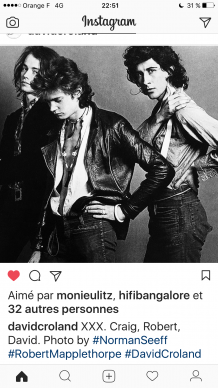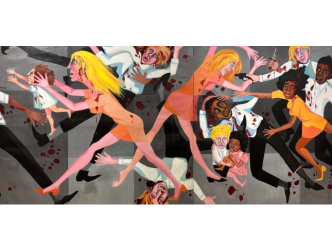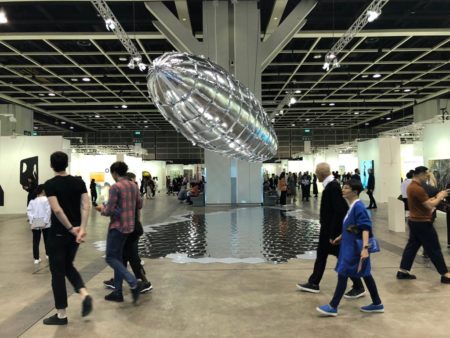The Thaddaeus Ropac Gallery in Paris is showing the early works of Robert Mapplethorpe. Each is unique and made in his own hand. Some pieces incorporate photography, but not all of them.
It’s proof – if proof is still needed – that Robert Mapplethorpe was not simply a great photographer but a great artist.
It’s worth mentioning that the works from Mapplethorpe’s early period were documented and commented upon in Robert Mapplethorpe: the Archive, a magnificent and major book published by Getty last year. You can read my report about it here.
For the occasion, I’m translating an excerpt from ‘The Life of Robert Mapplethorpe in Black and White’, my biography of the artist published by Grasset in March 2014 (never translated in English and that’s a shame!) after having interviewed more than 40 persons who happened to know Robert Mapplethorpe.
When Robert Mapplethorpe was producing these kinds of objects, he was embarking on his first homosexual relationship. It was a love affair with David Croland, at a time when he was still going out with Patti Smith.
‘In 1970 Robert Mapplethorpe met David Croland. He was a model and an illustrator. A handsome boy, sensitive and refined, who moved in Andy Warhol’s circle. The pair are languorously filmed in Sandy Daley’s film Robert Having His Nipple Pierced. Furtive caresses. Naked torsos. Soft touches. Full of affection and complicit smiles while Patti talks and talks and talks in that voice of hers, when it was still reedy.
In his article for the Village Voice in December 30 1971, Bob Colacello offers unexpected details about the punk poet’s monologue:
‘In sharp counterpoint to the delicacy of the visuals is the harsh and hilarious soundtrack by Patti Smith, poet , Robert’s ex-gril friend, and proud owner of the english speaking world most extravagant New Jersey accent, who it seems, dislikes homosexual because a) she feels left out b) ” they use their assholes”.
Miss Smith, of course, doesn’t really like or dislike any thing too much which the exception of talking, which she loves.’
Like in the film, the future lovers’ first advances were modesty personified.
David Croland spoke about it in detail more than forty years later: ‘It was in the summer of ’70. It was very hot.
I went to his loft. It was a friend who brought me there. The space was very empty. No bathroom, no kitchen. It was very bohemian. You won’t find anything like that in New York nowadays. Well, maybe in Brooklyn…
So Robert and Patti were there, both were very charming. I had a car at the time which my brother had given me after I came back from Europe.
I don’t know how it happened but at the end we all left, Robert, a friend, and me. Patti couldn’t come.
Before we left, we were sat on a sofa and he placed his hand behind my back. He made the first move. He had a girlfriend. I wasn’t going to create problems. I already had enough problems at that time.
So he put his hands around my waist and then we went out. In the street he held my hand. But not in front of everybody. He didn’t want everybody to see. I didn’t either. Robert acted more like a heterosexual at that time. So did I.
–More?
– I never said I was gay. And I still don’t today. I don’t like the word gay. I think it’s ridiculous. But I don’t deny anything. I do what I do… So very quickly we became boyfriends. But we had to hide it. We didn’t tell anyone anything for four months.’
Then came the mini-psychodrama, where the lovers didn’t want to be apart. Patti found out about it.
‘I had an apartment with a beautiful bathroom. He was often there. We were spending a lot of time together.
– What was he like? What was special about him?
– Everything. The person I’m with has to have everything. He was gentle, beautiful, talented, intelligent, cool and very sexy. He was everything.
–At that time was he already taking photos?
– No, he was making assemblages, collages. I introduced him to John McKendry (1) who gave him his first Polaroid.
Patti Smith and I were his first models.
I was his first male model.
I mean, it was with me that he did his first really serious male photos.
People ask me all the time: ‘What was it like being his first model?’ I tell them it was effortless, because right from the start Robert knew exactly what he was doing and what he wanted.
‘Move your arm this way or better yet like this…’
– What was his relationship with McKendry?
– At the time, I had a somewhat dramatic nature. One day he told me that he was going to Paris with McKendry. I told him: ‘If you do that I never want to see you again. He replied: ‘You’re kidding?’ I said: ‘No, it’s over. Finished. You’re my boyfriend. You’re not going anywhere with him.’ He answered that it was an opportunity, that he had to go. He said that he wasn’t in love with John and that nothing was going to happen between them. Of course there was nothing there, but John was deeply in love with him. Then he left for Paris, for several months, or maybe a couple of months. I received all these postcards from him, giving me details about the trip. Like ‘I met Pierre Bergé today.’ I had introduced them during one of his visits to New York. Yves and Pierre took him to the Left Bank and told him to choose a shirt. You can’t imagine how excited he was. He chose a silk shirt. Afterwards, they all went for dinner. He also met Ileana Sonnabend, who was meant to organise an exhibition of his first Polaroids. But it never happened.
Then Robert came back. We picked up our relationship where we’d left it off.
– It was a passion?
– He kept taking photos of me. I produced illustrations for the fashion designer Halston. I was drawing all these women, his clients, like Paloma Picasso, Loulou...
Robert and I, to earn a little cash, we found these extraordinary bracelets from the ’40s and ’50s at the corner of 14th Street. We bought them for $5. We resold them for $100 apiece to his clients.
We were a bit dumb but we were happy.
We did little businesses like that, but then Robert began to change.’(…)
Until 29 April: http://ropac.net
(1)John McKendry was curator in charge of photography and works on papers at Metropolitan museum at that time. He was also the husband of Maxime de la Falaise, a friend of Andy Warhol and mother of Loulou de la Falaise, muse of Yves Saint Laurent.
Support independent news on art.
Your contribution : Make a monthly commitment to support JB Reports or a one off contribution as and when you feel like it. Choose the option that suits you best.
Need to cancel a recurring donation? Please go here.
The donation is considered to be a subscription for a fee set by the donor and for a duration also set by the donor.














